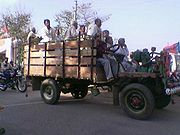Jugaad! Innovation Personified
 In villages of India, farmers have been using bullock carts for taking their yield to market and to ferry people. Over time, rich farmers bought tractors and other motor vehicles however those who couldn't afford these, innovated their way out of this.
In villages of India, farmers have been using bullock carts for taking their yield to market and to ferry people. Over time, rich farmers bought tractors and other motor vehicles however those who couldn't afford these, innovated their way out of this.
A Jugaad carrying passengers to a political rally in Agra, India.
A Jugaad is an innovative method of transportation that is used in some parts of northern India. It is constructed entirely out of a few handy and readily available tools. What was intially just an innovation by one farmer proved to be a boon for many people.

 In India, 4th December is celebrated as Navy Day. On this day Indian Navy played a significant role in the bombing of Karachi harbor in the 1971 war i.e. Operation Trident which was launched on December 4. Owing to its success, the day of the attack has been celebrated as Navy Day since then.
In India, 4th December is celebrated as Navy Day. On this day Indian Navy played a significant role in the bombing of Karachi harbor in the 1971 war i.e. Operation Trident which was launched on December 4. Owing to its success, the day of the attack has been celebrated as Navy Day since then. The national emblem of India is a replica of the Lion at Sarnath, near Varanasi in Uttar Pradesh. The Lion Capital was erected in the third century BC by Emperor Ashoka to mark the spot where the Buddha first proclaimed his gospel of peace and emancipation. The national emblem is thus symbolic of contemporary India's reaffirmation of its ancient commitment to world peace and goodwill.It was adopted as the National Emblem of India on 26 January 1950, the day that became a republic. The four lions (one hidden from view), symbolising power, courage and confidence, rest on a circular abacus. The abacus is girded by four smaller animals, that are considered guardians of the four directions: the lion of the north, the elephant of the east, the horse of the south and the bull of the west. The abacus rests on a lotus in full bloom, exemplifying the fountainhead of life and creative inspiration. The motto 'Satyameva Jayate' inscribed below the emblem in Devanagari script means 'truth alone triumphs'.This is a quote from Mundaka Upanishad the concluding part of the sacred Hindu Vedas.
The national emblem of India is a replica of the Lion at Sarnath, near Varanasi in Uttar Pradesh. The Lion Capital was erected in the third century BC by Emperor Ashoka to mark the spot where the Buddha first proclaimed his gospel of peace and emancipation. The national emblem is thus symbolic of contemporary India's reaffirmation of its ancient commitment to world peace and goodwill.It was adopted as the National Emblem of India on 26 January 1950, the day that became a republic. The four lions (one hidden from view), symbolising power, courage and confidence, rest on a circular abacus. The abacus is girded by four smaller animals, that are considered guardians of the four directions: the lion of the north, the elephant of the east, the horse of the south and the bull of the west. The abacus rests on a lotus in full bloom, exemplifying the fountainhead of life and creative inspiration. The motto 'Satyameva Jayate' inscribed below the emblem in Devanagari script means 'truth alone triumphs'.This is a quote from Mundaka Upanishad the concluding part of the sacred Hindu Vedas.

